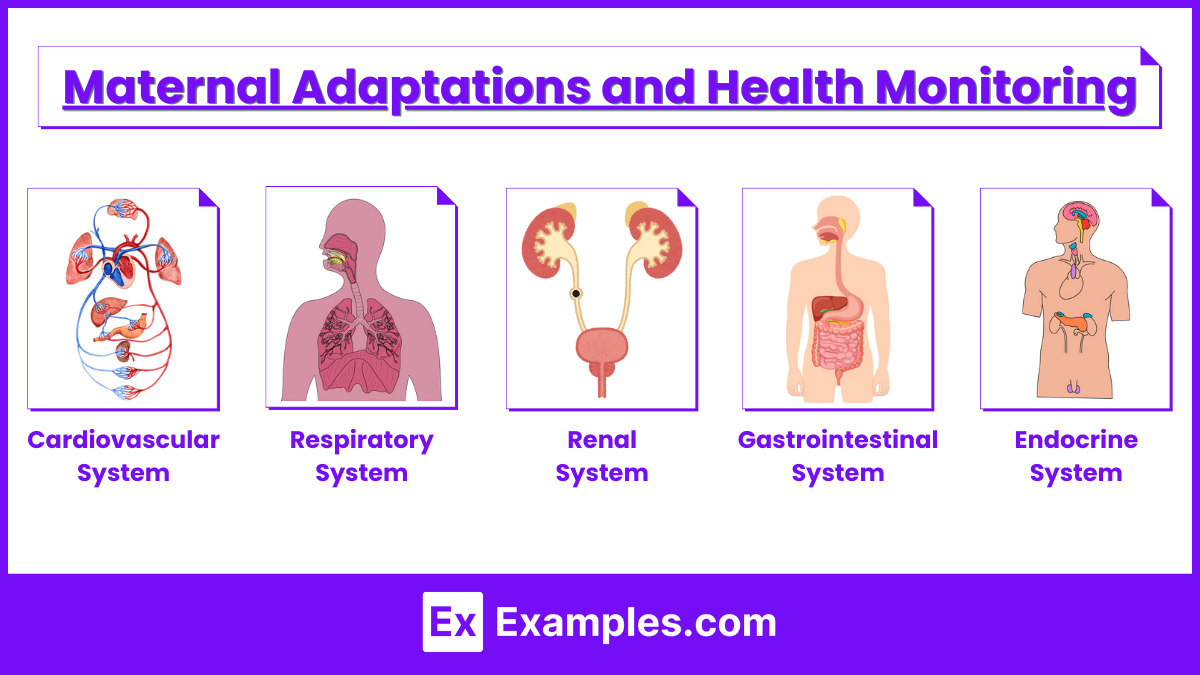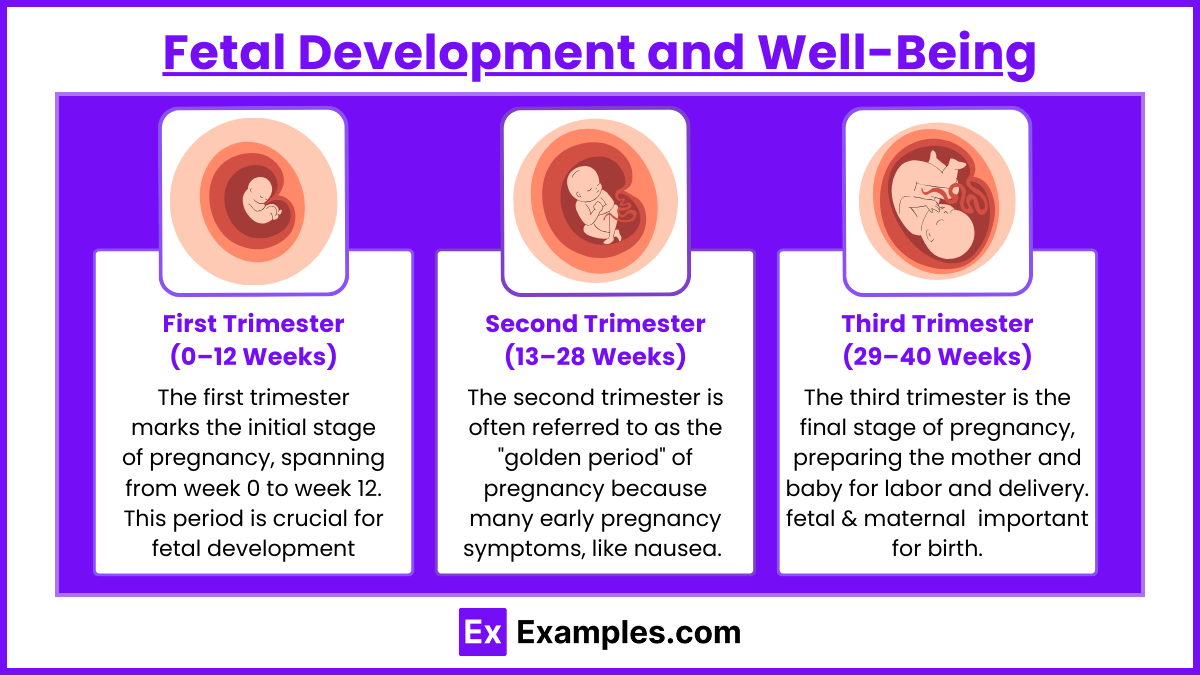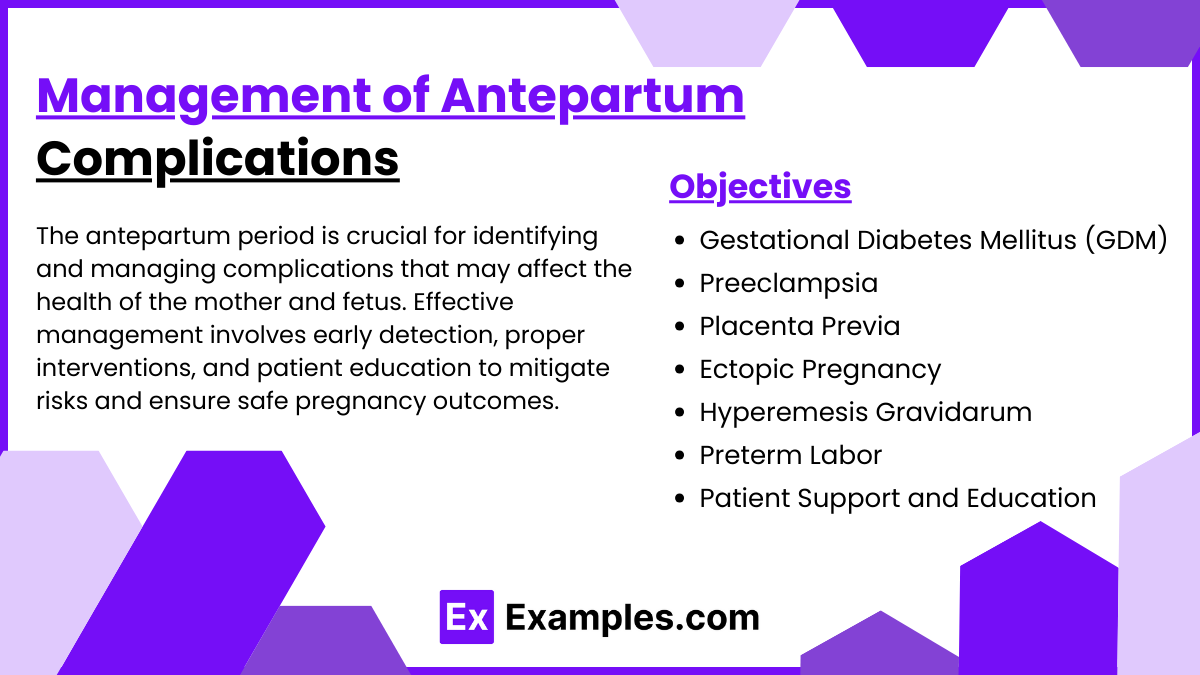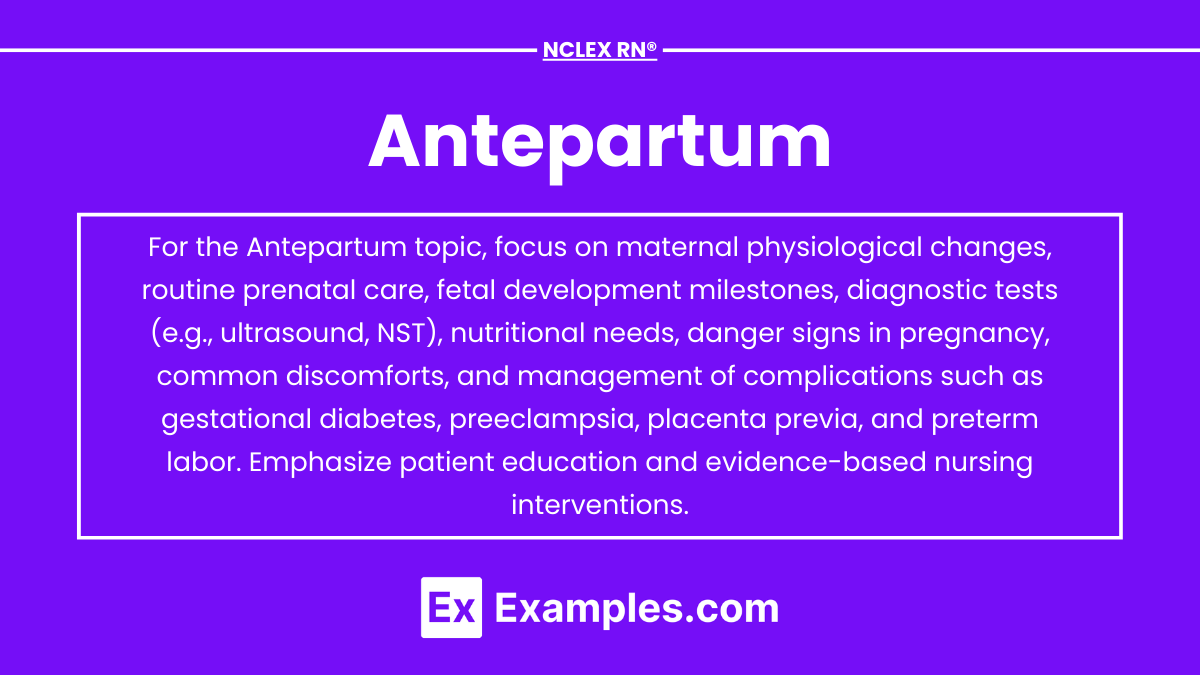The antepartum period, encompassing conception to labor onset, is vital for ensuring maternal and fetal health. This phase involves comprehensive prenatal care, including health assessments, nutritional guidance, fetal monitoring, and early detection of complications. Nurses play a key role in supporting mothers through physiological and emotional changes while educating them about self-care and warning signs. A strong understanding of antepartum principles is essential for the NCLEX RN® exam, as it tests critical thinking and nursing interventions for promoting positive pregnancy outcomes.
Learning Objectives
In studying “Maternal & Newborn Health: Antepartum” for the NCLEX RN® exam, you should learn to understand the physiological changes of pregnancy and their impact on maternal and fetal health. Analyze routine prenatal care, including assessments, diagnostic tests, and patient education. Evaluate common complications such as gestational diabetes, preeclampsia, and placenta previa, focusing on early recognition and nursing interventions. Additionally, explore the principles of fetal development, nutritional needs, and danger signs during pregnancy. Apply your understanding to prioritize care, educate patients effectively, and interpret clinical scenarios presented in NCLEX-style practice questions to ensure maternal and neonatal well-being.
Maternal Adaptations and Health Monitoring

The antepartum period involves significant physiological and psychological changes in the mother’s body to support the growing fetus. Proper health monitoring during this time ensures the well-being of both the mother and the baby while identifying and addressing potential complications early.
Maternal Physiological Changes
1. Cardiovascular System
- Increased Blood Volume: Maternal blood volume increases by 30–50% to meet the oxygen and nutrient demands of the fetus and to prepare for blood loss during delivery. This may cause mild anemia, also known as dilutional anemia.
- Increased Cardiac Output: The heart works harder, leading to a rise in heart rate by 10–15 beats per minute. Pregnant women may feel occasional palpitations, which are usually normal.
- Blood Pressure Changes: Blood pressure decreases slightly in the second trimester due to vasodilation caused by progesterone. By the third trimester, it returns to pre-pregnancy levels.
2. Respiratory System
- Increased Oxygen Demand: Pregnancy increases the body’s oxygen requirements, causing a 30–40% rise in tidal volume. This can lead to shortness of breath, especially in the third trimester.
- Altered Breathing Pattern: Mild hyperventilation occurs, which helps facilitate oxygen exchange between the mother and fetus.
3. Renal System
- Increased Kidney Function: The glomerular filtration rate (GFR) increases by 50%, allowing efficient excretion of waste products from both mother and fetus.
- Urinary Stasis: Dilation of the ureters due to progesterone increases the risk of urinary tract infections (UTIs).
- Frequency of Urination: Increased pressure on the bladder in the first and third trimesters leads to more frequent urination.
4. Gastrointestinal System
- Slowed Motility: Progesterone relaxes smooth muscles, slowing gastric emptying and intestinal motility. This can cause constipation, bloating, and heartburn.
- Changes in Appetite: Nausea and vomiting (morning sickness) are common in the first trimester due to hormonal changes, particularly increased levels of hCG.
5. Endocrine System
- Hormonal Shifts:
- hCG: Maintains the corpus luteum and progesterone production.
- Progesterone and Estrogen: Support uterine growth, relax smooth muscles, and prepare the breasts for lactation.
- Relaxin: Softens ligaments and joints to prepare for childbirth.
Fetal Development and Well-Being

Fetal development and well-being focus on the intricate process of growth and maturation of the fetus during pregnancy. This includes the physical, neurological, and functional development of the fetus from conception to birth, as well as ensuring the fetus remains healthy and safe throughout gestation. Nurses must be familiar with fetal development stages, diagnostic assessments, and interventions to ensure optimal outcomes, as this knowledge is critical for the NCLEX RN® exam.
Stages of Fetal Development
1. First Trimester (0–12 Weeks) : The first trimester marks the initial stage of pregnancy, spanning from week 0 to week 12. This period is crucial for fetal development and maternal health monitoring, as most of the baby’s major organs and systems begin to form.
- Major Organ Formation:
- The heart begins to beat at approximately 5–6 weeks.
- The neural tube, which develops into the brain and spinal cord, forms by week 4. Adequate folic acid intake is critical during this stage to prevent neural tube defects.
- Key Milestones:
- By week 8, all major organ systems are present, though immature.
- The fetus measures approximately 1 inch long and weighs less than an ounce by the end of the trimester.
2. Second Trimester (13–28 Weeks) : The second trimester is often referred to as the “golden period” of pregnancy because many early pregnancy symptoms, like nausea and fatigue, subside. This period focuses on fetal development and maternal health monitoring.
- Growth and Development:
- The fetus grows rapidly, with noticeable increases in size and weight.
- By week 20, the mother typically feels fetal movements, known as quickening.
- Organ Maturation:
- The lungs begin to develop structures necessary for breathing, and surfactant production starts at approximately 24 weeks.
- The fetal liver starts producing red blood cells.
- Physical Features:
- The fetus develops hair, eyelashes, and eyebrows.
- Skin appears wrinkled due to lack of subcutaneous fat.
3. Third Trimester (29–40 Weeks) : The third trimester is the final stage of pregnancy, preparing the mother and baby for labor and delivery. Both fetal maturation and maternal preparation for birth are key priorities.
- Final Growth and Weight Gain:
- The fetus gains most of its weight during this period, averaging about 5–6 pounds by birth.
- Lung Maturation:
- By 37 weeks, surfactant levels are sufficient for breathing outside the womb, marking the lungs as fully mature.
- Neurological Development:
- The brain grows rapidly, and the nervous system becomes more refined, allowing for reflex development (e.g., grasping and sucking reflexes).
- Term Birth:
- By 40 weeks, the fetus is considered full-term and ready for delivery, with all organs functioning optimally.
Diagnostic Tests for Fetal Well-Being

1. Ultrasound
- Used throughout pregnancy to assess fetal development, confirm gestational age, and detect anomalies.
- During the first trimester, it identifies the location of the pregnancy (intrauterine or ectopic) and confirms viability.
- In later trimesters, it monitors fetal growth, amniotic fluid levels, and placental health.
2. Non-Stress Test (NST)
- Evaluates fetal heart rate in response to fetal movements.
- A reactive NST (normal) indicates a healthy, oxygenated fetus, with at least two accelerations in heart rate over 20 minutes.
3. Biophysical Profile (BPP)
- Combines an NST with ultrasound to assess five parameters: fetal breathing movements, gross body movements, fetal tone, amniotic fluid volume, and fetal heart reactivity.
- Each parameter scores 0–2 points, with a total score of 8–10 indicating fetal well-being.
4. Amniocentesis
- Performed in the second trimester to detect genetic abnormalities or in the third trimester to assess fetal lung maturity.
- Amniotic fluid is analyzed for markers like lecithin/sphingomyelin (L/S) ratio, indicating surfactant production.
Management of Antepartum Complications

The antepartum period is crucial for identifying and managing complications that may affect the health of the mother and fetus. Effective management involves early detection, proper interventions, and patient education to mitigate risks and ensure safe pregnancy outcomes. Below are key antepartum complications and their management strategies.
Common Antepartum Complications
- Gestational Diabetes Mellitus (GDM):
- Screened with oral glucose tolerance test at 24–28 weeks.
- Managed through diet, exercise, and sometimes insulin therapy.
- Complications include macrosomia, preterm birth, and neonatal hypoglycemia.
- Preeclampsia:
- Symptoms: Hypertension, proteinuria, headache, and visual disturbances.
- Managed with antihypertensives, magnesium sulfate for seizure prevention, and monitoring.
- Placenta Previa:
- Presents as painless vaginal bleeding.
- Diagnosed with ultrasound; avoid vaginal exams.
- Requires delivery via cesarean section if placenta blocks cervical opening.
- Ectopic Pregnancy:
- Severe abdominal pain and potential bleeding.
- Requires immediate medical intervention, often methotrexate or surgery.
Hyperemesis Gravidarum
- Severe, persistent nausea and vomiting leading to dehydration.
- Managed with IV fluids, antiemetics, and electrolyte repletion.
- Monitor for weight loss and malnutrition.
Preterm Labor
- Occurs before 37 weeks gestation.
- Symptoms: Regular contractions, pelvic pressure, backache.
- Interventions: Tocolytics (e.g., magnesium sulfate), corticosteroids for fetal lung maturity.
Patient Support and Education
- Provide emotional support for high-risk pregnancies.
- Educate on lifestyle changes to minimize risks (e.g., stress reduction, adequate rest).
- Encourage compliance with prenatal care visits and prescribed treatments.
Examples
Example 1. Recognizing Danger Signs in Pregnancy
A pregnant client at 28 weeks gestation reports a sudden onset of severe headaches, blurred vision, and swelling in her hands and face. The NCLEX RN® may present this scenario to assess your ability to identify preeclampsia and implement appropriate interventions. Your actions should include assessing blood pressure, monitoring urine for proteinuria, and preparing to administer antihypertensive medications or magnesium sulfate if necessary.
Example 2. Educating on Nutritional Needs During Pregnancy
A 20-week pregnant client asks about dietary recommendations to support her baby’s growth. In this NCLEX scenario, you may be required to educate the client about increasing caloric intake by 300 calories/day, consuming folic acid (400–800 mcg daily), and maintaining adequate iron and calcium levels. You may also address managing common discomforts such as constipation by recommending high-fiber foods and hydration.
Example 3. Managing Gestational Diabetes Mellitus (GDM)
A 32-week pregnant client diagnosed with GDM is struggling to maintain blood sugar levels within the target range. The NCLEX RN® may test your knowledge of educating the client on blood glucose self-monitoring, dietary changes, and the potential need for insulin therapy. Additionally, you might need to discuss fetal monitoring and the importance of maintaining blood glucose levels during labor to prevent neonatal complications like hypoglycemia.
Example 4. Interpreting Results of Fetal Assessments
A pregnant client undergoes a non-stress test (NST) at 36 weeks gestation. The NCLEX RN® could ask you to interpret results indicating a reactive NST (two or more accelerations in fetal heart rate over 20 minutes), signifying normal fetal oxygenation. In contrast, a non-reactive NST may require further testing, such as a biophysical profile (BPP) or contraction stress test (CST).
Example 5. Educating on Preventing Preterm Labor
A client at 30 weeks gestation presents with regular contractions and pelvic pressure. The NCLEX may challenge you to implement immediate interventions such as administering tocolytics (e.g., magnesium sulfate) to stop contractions and corticosteroids (e.g., betamethasone) to accelerate fetal lung maturity. Additionally, patient education on signs of preterm labor and lifestyle modifications (e.g., avoiding heavy lifting and maintaining hydration) may be assessed.
Practice Questions
Question 1
A pregnant client at 28 weeks gestation reports severe headaches, blurred vision, and swelling in her hands and face. Her blood pressure is 160/100 mmHg, and a urine dipstick test reveals proteinuria. Which condition is the client most likely experiencing?
A) Gestational diabetes
B) Placenta previa
C) Preeclampsia
D) Hyperemesis gravidarum
Answer: C) Preeclampsia
Explanation:
- Preeclampsia is characterized by hypertension (≥140/90 mmHg), proteinuria, and signs of end-organ damage such as headaches, visual disturbances, and edema. The client’s symptoms of severe headache, blurred vision, and swelling in her hands and face, along with elevated blood pressure and proteinuria, strongly indicate preeclampsia.
- Gestational diabetes is associated with glucose intolerance but does not typically involve these symptoms.
- Placenta previa is marked by painless vaginal bleeding and does not cause these systemic symptoms.
- Hyperemesis gravidarum involves severe nausea and vomiting leading to dehydration, not hypertension or proteinuria.
Question 2
During a prenatal visit, a nurse teaches a client in her first trimester about avoiding teratogens. Which client statement indicates a need for further teaching?
A) “I will avoid drinking alcohol during pregnancy.”
B) “I can continue taking my prescribed isotretinoin for my acne.”
C) “I will not smoke cigarettes while I’m pregnant.”
D) “I should avoid contact with cat litter during pregnancy.”
Answer: B) “I can continue taking my prescribed isotretinoin for my acne.”
Explanation:
- Isotretinoin is a teratogenic medication known to cause severe birth defects and must be avoided during pregnancy. Continuing this medication indicates a need for further teaching.
- Alcohol and cigarette smoking are also teratogenic and correctly identified as substances to avoid.
- Cat litter can expose pregnant women to toxoplasmosis, a parasitic infection harmful to the fetus. Avoiding cat litter demonstrates proper understanding.
Question 3
A client at 34 weeks gestation is undergoing a non-stress test (NST). The nurse observes two accelerations in fetal heart rate (FHR) of 15 beats per minute lasting 20 seconds each within a 20-minute period. How should the nurse interpret this finding?
A) Non-reactive NST, further testing required
B) Reactive NST, fetal well-being indicated
C) Inconclusive NST, repeat in 30 minutes
D) Abnormal NST, prepare for delivery
Answer: B) Reactive NST, fetal well-being indicated
Explanation:
- A reactive NST is characterized by at least two fetal heart rate accelerations of 15 beats per minute above baseline lasting for at least 15 seconds each within a 20-minute monitoring period. This indicates fetal well-being.
- A non-reactive NST requires further testing, such as a biophysical profile (BPP), but this is not the case here.
- An inconclusive NST would involve insufficient data or variability in results, which does not apply here.
- An abnormal NST suggesting the need for immediate delivery is not indicated by the described findings.


